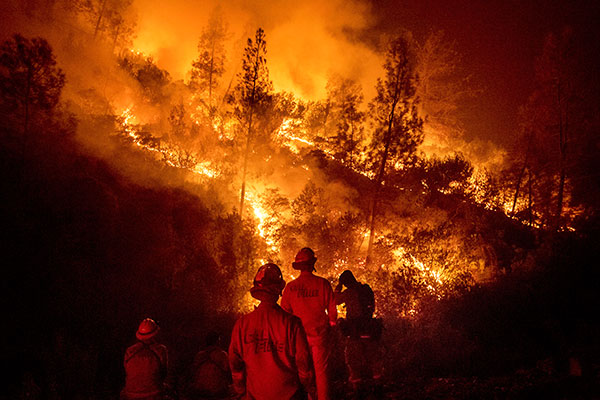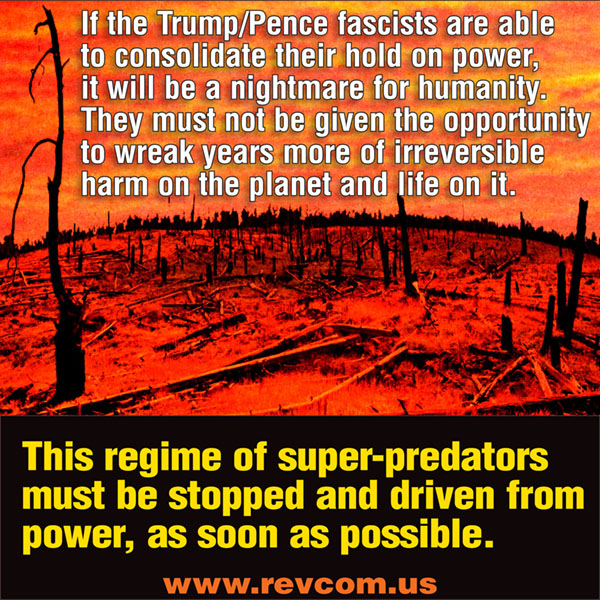California’s Wildfires, Global Warming, and the Threat to the Planet
| Revolution Newspaper | revcom.us
From a reader:
California is burning. Seventeen major forest fires are currently blazing across the state. These fires are causing massive human suffering and environmental degradation. The increase in the number and intensity of these fires is being driven, in large part, by climate change caused by the capitalist-imperialist system. The burning of fossil fuels pumps immense rivers of greenhouse gases into the atmosphere and is the main thing driving the increase in global temperatures and drastically transforming the planet.
Plundering the Earth for coal, oil, and natural gas to fuel the global economy is deeply woven into the workings of capitalism-imperialism. This system can’t rid itself of this addiction because capitalists are forced to ruthlessly compete with each other for maximum returns and strategic advantage, driving them to use the cheapest and most widely available sources of energy, and treating environment impacts of their production—like greenhouse gas emissions—as something “external”—not factored into their profit and loss calculations. Instead these environmental costs are off-loaded onto society and the planet.
The cutthroat competition that propels capitalism means the capitalists can’t afford to do otherwise—no matter their professed, or even sincere, environmental concerns. This is why in 2017—when report after report warned of the danger of rising global temperatures—the world pumped out MORE greenhouse gases than in any previous year, and the last four years have been the hottest ever recorded.
This is why this system cannot be reformed and is incapable of protecting the Earth. This is one more reason why only revolution that overthrows capitalism and puts a new, radically different socialist system in its place, can save the planet.1
Wildfires in California have been intensifying over many years. As global warming increases temperatures, hot and dry air parches forests, making them more combustible. Seven of the most destructive wildfires in California history have occurred just in the past 10 months. The average number of acres burned in California’s wildfires has doubled in recent years.
California governor Jerry Brown said the massive fires that have hit California in recent years are the “new normal.” But as horrible as these current fires are, what we are seeing is not a “new normal”; the situation has in no way stabilized—the current trajectory is for increasingly higher temperatures, drier forests, and more and more intense fires—in California and around the world.
The Fires of 2018 (so far)
The Mendocino Complex Fire is now the largest in California history. It has burned more than 468 square miles. As of August 10, it was only 49 percent contained and Cal Fire, the State Department of Forestry and Fire Protection, estimates that it will continue to burn until early September.
At least eight people have been killed by the Carr Fire, burning near the city of Redding. More than 35,000 people have been evacuated and more than 1,000 homes have burned. Melanie Bledsoe, 70, and her two great grandchildren, ages four and five, died when they did not have a car to flee the fire.
KRCR-TV spoke with some of the thousands who have been displaced by the fires. “It’s a nightmare for everybody here,” said Brenda Walker, one of the thousands of evacuees, who was on her third day camping out in an emergency shelter using ice packs to stay cool. It has been over 100 degrees every day since they were displaced. Brenda’s eight-year-old son is autistic. “The whole trailer park went up engulfed in flames,” she said. “We had no time to pack up and get a lot of stuff; the cops came in saying, ‘You have to evacuate now.’” When KRCR interviewed her, she had no idea if her home was still standing or if she had lost everything.
This is not even peak wildfire season. The National Interagency Fire Center recently predicted that August “will be a very active month” with what it calls “above normal significant” potential for wildfires across parts of the Pacific Northwest, Northern Rockies, the northern Great Basin, and California.
Today the fire season in the western U.S. stretches, on average, 78 days longer than in the mid-1980s. Higher summer temperatures result in earlier snowmelt. Western forests typically become combustible within a month of when snowmelt is complete. Snowpack melts one to four weeks earlier than it did 50 years ago.
These fires are coming less than a year after a wave of fires hit the state in October 2017. One of those, the Tubbs Fire, killed 22 people and destroyed 2,800 homes in Sonoma County.
Smoke from the blazes is poisoning the air. In parts of southern Oregon, hundreds of miles to the north, ground-based sensors measured particle pollution levels as bad as it gets in Beijing on a badly polluted day. Smoke from the fires, thrown high in the atmosphere, is reaching as far away as New York.
The full toll of this air pollution may not be immediate. Recent research following the enormous fires in Indonesia in the past few years suggests that lung disease from smoke and particulate matter may have caused more than 100,000 additional premature deaths across Indonesia, Malaysia, and Singapore.
The intensity of these fires is giving rise to new features that make them more destructive and harder to control. A fire vortex, called a “fire tornado,” with winds topping 143 miles per hour, ripped through Redding. The plume rose 35,000 feet in the air, making it visible to meteorologists in Sacramento, 100 miles to the south. Trees were uprooted, cars thrown in the air, major power lines destroyed.
“Fires are moving faster than anyone has ever seen, and barriers that in years past contained fires—bulldozer lines, highways, rivers—are now no match,” the New York Times reported (August 7, 2018).
A Worldwide Inferno
A July 30, 2018 paper by the World Meteorological Organization, a group made up of representatives of 191 nations, reads, “The unusually hot and dry summer in parts of the northern hemisphere has turned fields and forests into fuel for fires which are raging from the Arctic to the Mediterranean and West Coast of North America. These wildfires have caused dozens of fatalities and are devastating large regions, with far-reaching impacts for the environment, ecosystems, human health and the climate.”
In a recent opinion piece in the New York Times, three professors of biology and environmental science argue, “Widespread fires this year have magnified concerns that we are locked in a worldwide pattern of conflagration that is both persistent and catastrophic. Wildfires have been even more pervasive in 2018 in central and northern Europe than last year, including the United Kingdom, Sweden, Denmark, Estonia, Finland, Latvia, Malta, the Netherlands, Poland and Germany. In Greece, east of Athens, some 90 people were killed. (Last year in Portugal, more than 100 people died in wildfires, including at least 30 people who were trapped in their cars when flames engulfed a road.)” (“The Earth Ablaze,” August 8, 2018)
One feature of the 2018 fire season has been the spread of major fires to areas where they have rarely been seen, such as parts of Siberia and Sweden inside the Arctic Circle. In early July, fires in Siberia sent smoke across the Arctic Ocean to Alaska and, eventually, the west coast of Greenland. More than 50 wildfires erupted in Sweden, their worst fires in 75 years.
Rising temperatures are also dramatically changing weather patterns, increasing the frequency of droughts and threatening the livelihoods of billions. The New York Times (August 9) reports that “Climate change could sharply diminish living conditions for up to 800 million people in South Asia [Afghanistan, Pakistan, India, Bangladesh, Nepal, and Sri Lanka], a region that is already home to some of the world’s poorest and hungriest people...” Agriculture and farming in the Middle East, North Africa, Central America, Australia, and other regions are also being hammered by the impacts of global warming.
What Destroying Forests Means for the Planet
Forests play a crucial role in the environment. They provide clean water, lock up carbon (the main cause of climate change), and shelter whole ecosystems. Devastated forests leave birds, mammals, and other living things that rely on them without food, shelter, or the means for survival. Their beauty and biologic diversity enriches us all.
In relation to global warming, the destruction of forest areas contributes to what is called a negative feedback loop, where increased temperatures and other climate changes kill trees and forests. Because the forests no longer lock up carbon, global warming increases, leading to more dying forests, and on and on.
The New York Times op-ed by the three biologists warns, “What has been particularly worrisome in recent years is that the world’s largest forests, the taiga of Russia and its boreal forest cousins that ring the Arctic and store much of the world’s carbon, experienced wildfires at a rate and scale not seen in at least 10,000 years, according to paleoecological records.”
One of humanity’s goals should be to protect the precious resources of our planet and to leave it in better shape for future generations. The Earth’s forests, and much else, have already been damaged in ways that cannot be easily reversed. The destruction is ongoing and intensifying. We must act NOW, with the urgency that the situation demands, to make revolution, put an end to the capitalist-imperialist system, and stop the destruction of the planet.
1. For more on the dynamics of capitalism-imperialism, see Raymond Lotta, “On the ‘Driving Force of Anarchy’ and the Dynamics of Change. A Sharp Debate and Urgent Polemic: The Struggle for a Radically Different World and the Struggle for a Scientific Approach to Reality.” [back]

Seventeen major forest fires are currently blazing across California. The increase in the number and intensity of these fires is being driven, in large part, by climate change caused by the capitalist-imperialist system. Here, the Ranch fire, part of Mendecino Complex Fire, California, August 7. (Photo: AP)
Watch Bob Avakian: "Not Fit Caretakers of the Earth," a clip from the film Revolution: Why It's Necessary, Why It's Possible, What It's All About, a film of a talk by Bob Avakian given in 2003 in the United States.
CONSTITUTION For The New Socialist Republic In North America
(Draft Proposal)
Authored by Bob Avakian, and adopted by the Central Committee of the RCP
Get a free email subscription to revcom.us:

Volunteers Needed... for revcom.us and Revolution
If you like this article, subscribe, donate to and sustain Revolution newspaper.


